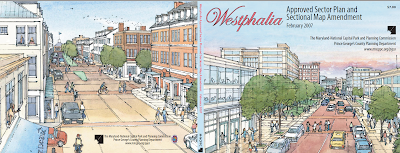This article is Part 2 of a two-part series to help demystify the County Council redistricting process in Prince George’s County and explain the impact it can have on our lives. A version of this series appeared on Greater Greater Washington.
On September 1, the Prince George’s County Redistricting Commission submitted its proposed 2021 redistricting plan for the County Council. The council will hold a public hearing later this month to determine whether to allow this plan to take effect, or whether to enact its own plan. The Council must make its decision by November 30.
In Part 1 of this series, we discussed the Redistricting Commission’s proposed plan and described how it disadvantages the lower-income and urbanized residents of the county who live inside the Beltway. We also showed how the commission failed to make a good-faith effort to equalize the population across the nine districts.
In this second part of the series, we discuss two potential alternatives that the County Council could consider: the “Sensible Communities” redistricting proposals prepared by citizen activist and Prince George’s Urbanist publisher Bradley Heard.
Alternative #1: Compact, contiguous districts that fairly represent urban and lower-income inner-Beltway communities
Bradley’s first proposed alternative, shown below, is based on a different set of criteria than those the commission adopted:
- The sum of the largest and smallest districts’ deviations from an ideal district (i.e., the “maximum population deviation”) must be less than 3.5% — a significantly stricter criterion than that adopted by the commission.
- All districts must be compact and contiguous. (Also required by the commission and the county charter.)
- Precincts should not be split between districts. (Also required by the commission.)
- Municipalities should not be split into multiple districts, and splits of census-designated places into multiple districts should be minimized.
- The half-mile walksheds of the Metro stations along any of the county’s four Metro line segments should not be split into multiple districts.
- Incumbents eligible for reelection should not be pitted against each other in a single district. (Not explicitly required by the commission, but their emphasis on a least-change map ensured it.)
- The plan should not
result in the denial or abridgement of the rights of any racial or
language minority group to participate in the political process. (As
required by the federal Voting Rights Act.)
Sensible Communities Redistricting Map Alternative #1,
created with the Dave’s Redistricting web tool by Bradley Heard.
(Download this KMZ file to view this map on Google Earth or Google Maps)
Bradley’s Alternative #1 plan divides the area inside the Beltway and some areas just outside it into five districts. Bradley’s proposed District 2 is very similar to the commission’s proposed District 2, and he divides the rest of the northern area inside the Beltway into District 3 and District 4. The northern Green Line corridor and the county’s most urban areas, including nearly all of its former streetcar suburbs, are divided between districts 2 and 3, while the Orange Line corridor, Lanham-Seabrook, and Glenarden are in District 5.
The Alternative #1 plan divides the central and southern portions of the county inside the Beltway almost entirely between District 6 (containing the Blue Line corridor, including the area around Largo) and District 7 (containing the southern Green Line corridor and Joint Base Andrews), except for the town of Forest Heights, which is contained in the northern tip of District 8.
The lower-income communities in the central and southern portions of the county inside the Beltway make up a majority of two districts in Bradley’s plan — districts 6 and 7 — instead of just one district, as they do under the commission’s plan. In addition, District 5 would represent a lower-income area than it does today, providing more representation on the council for the county’s low-income communities.
The proposed districts in the Sensible Communities Alternative #1 plan also provide better representation for the denser parts of the county inside the Beltway. All five of the districts with substantial areas inside the Beltway have median population densities above the county’s median value of 4,000 residents per square mile: 11,000 and 8,000 residents per square mile, respectively, for districts 2 and 3 in the northern portion of the county, and 5,000 to 5,500 residents per square mile for the three central/southern districts.
Furthermore, Bradley’s proposed districts are generally more compact than those proposed by the Redistricting Commission. Also, because his inner-Beltway districts largely follow Metro corridors, they represent areas that have related public transportation and urban planning concerns. Being linked by Metro would also make it easier for transit-dependent residents to attend events hosted by councilmembers in their district.
Alternative #2: A majority-Hispanic district, but with split municipalities and CDPs
One
issue that Bradley’s Alternative #1 map shares with the commission’s
plan is the absence of a majority-Hispanic district. The district with
the largest Hispanic population, District 2, has a voting-age population
that is 49.5% Hispanic. Bradley’s second proposal, shown below, adjusts
district boundaries, especially in the northern portion of the county,
to allow District 2 to include nearly all of the county’s
majority-Hispanic areas, giving it a voting-age population that is 54.5%
Hispanic.
Sensible Communities Redistricting Map Alternative #2,
created with the Dave’s Redistricting web tool
by Bradley Heard.
(Download this KMZ file to view this map on Google Earth or Google Maps)
Unfortunately, achieving this majority-Hispanic district requires breaking a number of municipalities into multiple districts, and increasing the number of splits of census-designated places. It also produces substantially less-compact districts than the first alternative. Whether these trade-offs are worthwhile is an open question, but both of these “Sensible Communities” alternative maps have substantial benefits compared to the map being proposed by the redistricting commission.
Both Alternatives Comport With “One Person, One Vote”
Unlike the Redistricting Commission’s proposed 2021 plan and the County Council’s current 2011 plan, both of Bradley’s Sensible Communities proposals make a good-faith effort to create districts with as nearly equal population as is practicable, in accordance with the mandates of the U.S. constitution and the county charter.
The 2011 redistricting plan has a maximum population deviation of 7.30%, and the redistricting commission’s proposed 2021 redistricting plan has a maximum population deviation of 6.96%. By contrast, the Sensible Communities Alternative #1 plan has a maximum population deviation of 1.44%, and the Alternative #2 plan has a maximum population deviation of 1.36%.
Bradley’s two citizen-drawn County Council redistricting plans demonstrate that it was entirely possible for the Redistricting Commission and the County Council to have achieved dramatic reductions in population deviation in the current 2011 plan and the proposed 2021 plan, while still observing traditional redistricting principles. That they did not do so is strong evidence that other illegitimate or discriminatory factors were likely motivating their drawing of district lines.
Show your support for Sensible Communities
The County Council has tentatively scheduled the public hearing on the redistricting commission’s plan to occur on Tuesday, September 28. There will presumably be an opportunity for the public to submit oral or written testimony in connection with that hearing. However, you do not need to (and should not) wait until the public hearing to make your wishes known to the council. The earlier you can give your input, the more likely it is that you can actually have an impact on the process.
The first thing you can do right now is to complete the feedback form on Bradley’s Sensible Communities page to let him know which plan(s) you support and to offer any further comments. He will be compiling a list of supporters and submitting it to the council.
The second thing you can do, if you’re a Prince George’s County resident, is to write to the councilmember for your district and the two at-large councilmembers and urge them to support the Sensible Communities plans.
Finally, please share your thoughts below in the comments, and share these posts with your friends to increase public awareness of this important once-a-decade task.
Ultimately, it’s up to all of us to help make our democracy better.


















